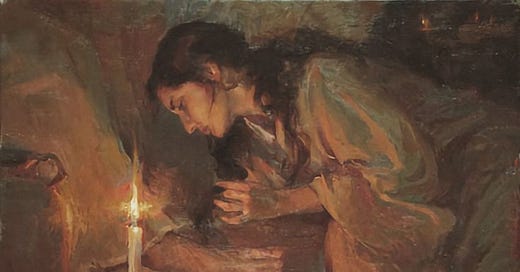There are two “alabaster jar” stories in the Gospels.
The first, recorded in Luke 7, describes a “sinful woman’s” (most likely a prostitute’s) audacious display of generosity and affection toward Jesus:
“A woman in that town who lived a sinful life learned that Jesus was eating at the Pharisee’s house, so she came there with an alabaster jar of perfume. As she stood behind him at his feet weeping, she began to wet his feet with her tears. Then she wiped them with her hair, kissed them, and poured perfume on them.” - Luke 7:37-38 NIV
The second, recorded in Matthew 26, Mark 14, and John 12 (with slight variations in detail) describes Mary of Bethany likewise anointing Jesus with expensive perfume:
“Six days before the Passover, Jesus came to Bethany, where Lazarus lived, whom Jesus had raised from the dead. Here a dinner was given in Jesus’ honour. Martha served, while Lazarus was among those reclining at the table with him.” ~ John 12:1-2 NIV
“While Jesus was in Bethany in the home of Simon the Leper, a woman came to him with an alabaster jar of very expensive perfume, which she poured on his head as he was reclining at the table.” ~ Matthew 26:6-13
“Then Mary took a pint of pure nard, an expensive perfume; she poured it on Jesus’ feet and wiped his feet with her hair. And the house was filled with the fragrance of the perfume.” ~ John 12:3
“Some of those present were saying indignantly to one another, ‘Why this waste of perfume? It could have been sold for more than a year’s wages and the money given to the poor.’ And they rebuked her harshly.
‘Leave her alone,’ said Jesus. ‘Why are you bothering her? She has done a beautiful thing to me.’” ~ Mark 14:4-6
There is so much to unpack in this story, and I promise to write a full devotional about it before Easter.
But this week, with our news feeds still cluttered by sappy Valentine’s Day posts, I wanted to share with you a poem I wrote about these two women and their lavish displays of love.
You see, I identify with both Mary of Bethany—a woman of deep emotion (Jn. 11:32-33) and keen intellectualism (Lk. 10:38-39)—and the sinful woman, ostracized by her society, in Luke 7.
This poem, which blends the two accounts, is my alabaster offering: an outpouring of shameless love and affection for the one who calls me “Beloved.”1
Call Me "Mary"
Call me “Mary”
standing in the doorway
waiting in the shadows
trembling
Call me “Mary”
Stepping forth
into the light
as all falls still
“Mary,” he calls me
by name
inviting me in
as all the men stare
“Mary,” he calls me
tenderly
as I fall at his feet,
breaking my vase
“Mary,” he whispers
as I shatter my alabaster
and the sweet perfume
spills onto his head
“Mary,” he declares
as the nard drips down
his noble brow
anointing his crown
“My lord,” I whisper
as I fall on my face
kissing his feet
“Forgive me.”
“Mary, O Mary—”
My tears spill forth
splashing, soaking
his careworn feet
“Mary, my child.”
Sobbing, shaking
Alabaster heart breaking
Kissing those feet
Dark tresses caressing
The feet where I sat
a woman among rabbis
a scholar among men
The feet caked in dust
at the mouth of the tomb
retrieving my brother
from the realm of the dead
Feet that crossed heaven
and earth for my heart
to raise me from shame
and call me forth from the dark
“Mary” is a name of Hebrew origin that carries two seemingly juxtaposed meanings: “bitter” and “beloved.”





Lovely 😊🙏🏼